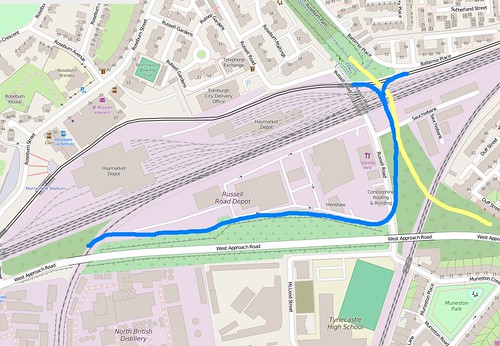As I attend a number of light rail meetings I'll confirm Kaputnik's info on the tyre profile for trams being very different to trains.
Train wheelset flanges are not used to steer the wheels around corners, they are tapered to not have the flanges touching the rails.
Tram wheelsets do use the inside of the flange to spread the load on tighter corners that trams run round by bearing on the keep on the grooved rail. In Sheffield the tram train project gave a choice of options
1) modify the railway track - mostly pointwork on the railway with a 2-stage check-rail/frog system to avoid the trams falling off the track.
2) change the grooved rail to take the railway profile wheelsets.
As track renewal was needed option 2 was chosen for Sheffield. For Edinburgh we have the factors of the obvious settlement of the track slab and supporting sub grade under the other parts of the carriageway - perhaps requiring significant attention on Shandwick Place in the not too distant future, with visible settlement cracking on the top screed of the track slab, and serious subsidence/breaking away for the manholes on the diverted services along Shandwick Place. Note the movement under the 8-10 ton load of a bus axle.
Equally on the street two pictures taken 2 months apart - same defect 28/11/15 vs 2/02/16
https://www.flickr.com/photos/h52/24705433841/in/datetaken/
https://www.flickr.com/photos/h52/23458343282/in/datetaken/
Good to see prompt action on repairs by Edinburgh Tram?
Them here's a look at what is happening to the relocated services on Shandwick Place - many right where people will be cycling
Watch the thing move as it gets hammered down
https://www.flickr.com/photos/h52/24503424330/in/datetaken/
and this one - right where people cycle
https://www.flickr.com/photos/h52/24798956355/in/datetaken/
And this bundle of bad
https://www.flickr.com/photos/h52/24772705056/in/dateposted-family/
https://www.flickr.com/photos/h52/24170773254/in/dateposted-family/
https://www.flickr.com/photos/h52/24681095192/in/dateposted-family/
The sub grade here is an allivial deposit over fissured shale, with some bores logging water present. The Tunnel at Scotland Street recorded running sand during its construction (HT @Arellcat for that research) This sort of supporting ground is weakened by water, and with the cracks and movement in the tarmac (sealed) surface every heavy vehicle driving over this pumps the wet ground, making it weaker and leaching away the finer material, increasing the rate at which the road sinks...
Back on topic.
Personally I'd look at how a connection might be made from the rump of the old Caley alignment that remains from Slateford yard and since the West Approach hardly warrants 4 lanes & wide verges take the railway back along that alignment diving down and under the streets to pop out via Kings Stables Road car park, and build a new set of tracks at the foot of the Castle Rock where there is just about enough space - relocating the park access on top of the railway. The West Approach sits right alongside the edge of the South Haymarket Tunnel - 2 new tracks going in to Waverley on the South side (outside the Klondyke Wall and connecting on the Sub platforms could bring in trains from Carlisle and South Lanarkshire - raising (or lowering) the car park would restore the old yard and provide 2-3 extra platforms, and the potential for a more direct route in to the main station from Calton Road (for Holyrood) Edinburgh Council offices, and the car park/ a better taxi drop-off point - and even cycle parking in the undercroft.
A tram-train option can cut across to the existing route - possibly along the Lothian Road alignment, and the tram (with increased frequency) has to go under Princes Street as has been done in most cities with seriously busy tram systems. This could deliver an all weather shopping arcade at basement level for many of the shops, a sheltered collonade looking out over Princes Street Gardens for viewing events, a public transport service which can continue to operate when Princes Street is closed off for major events, and provide a way to get the crowds in and out, and a tram stop directly integrated with Waverley Station and the St James's development through Waverley Market, and possibly the Scotland Street Tunnel or a short new link at the North Bridge Junction.
The key junctions for extending the network, at Lothian Road and Leith Street/North Bridge would be below ground keeping the easily damaged and dangerous to cyclists pointwork on a reserved track, and bringing the trams up in the middle of the street - where they traditionally were place and eliminating the pinch between tram tracks and kerbs where many cycle falls take place. Centrally placed tram tracks can also be built more cheaply using standard rails, and even grass to provide various environmental benefits (rainfall surge attenuation, conversion of COx and NOx, filtration of PM captured on plant leaves, climate management (1 gallon of water uses c.2.5 million calories of heat to evaporate) and production of oxygen (1-1.5 sq m of grass deliver the annual requirement for an adult)- with the added gain of property values from having a green space outside). In Brussels the on street reserved tracks then use conventional level crossings where roads cross the tracks, and these can be made cycle friendly more easily than a grooved rail in the road.


 posts
posts
